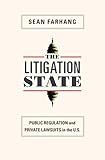The Litigation State : Public Regulation and Private Lawsuits in the U.S. / Sean Farhang.
Material type: TextSeries: Princeton Studies in American Politics: Historical, International, and Comparative Perspectives ; 113Publisher: Princeton, NJ : Princeton University Press, [2010]Copyright date: ©2010Edition: Course BookDescription: 1 online resource (320 p.) : 4 line illus. 6 tablesContent type:
TextSeries: Princeton Studies in American Politics: Historical, International, and Comparative Perspectives ; 113Publisher: Princeton, NJ : Princeton University Press, [2010]Copyright date: ©2010Edition: Course BookDescription: 1 online resource (320 p.) : 4 line illus. 6 tablesContent type: - 9780691143828
- 9781400836789
- KF8840
- online - DeGruyter
- Issued also in print.
| Item type | Current library | Call number | URL | Status | Notes | Barcode | |
|---|---|---|---|---|---|---|---|
 eBook
eBook
|
Biblioteca "Angelicum" Pont. Univ. S.Tommaso d'Aquino Nuvola online | online - DeGruyter (Browse shelf(Opens below)) | Online access | Not for loan (Accesso limitato) | Accesso per gli utenti autorizzati / Access for authorized users | (dgr)9781400836789 |
Browsing Biblioteca "Angelicum" Pont. Univ. S.Tommaso d'Aquino shelves, Shelving location: Nuvola online Close shelf browser (Hides shelf browser)

|

|

|

|

|

|

|
||
| online - DeGruyter Hard Line : The Republican Party and U.S. Foreign Policy since World War II / | online - DeGruyter The Clash of Ideas in World Politics : Transnational Networks, States, and Regime Change, 1510-2010 / | online - DeGruyter Religion and Democracy in the United States : Danger or Opportunity? / | online - DeGruyter The Litigation State : Public Regulation and Private Lawsuits in the U.S. / | online - DeGruyter The Limits of Constitutional Democracy / | online - DeGruyter A Behavioral Theory of Elections / | online - DeGruyter The Blame Game : Spin, Bureaucracy, and Self-Preservation in Government / |
Frontmatter -- CONTENTS -- Illustrations and Tables -- Acknowledgments -- Part I: Private Enforcement Regimes in General -- Chapter 1. An Introduction to Private Enforcement Regimes -- Chapter 2. Institutional Foundations of Private Enforcement Regimes -- Chapter 3. An Empirical Model of Enactment of Private Enforcement Regimes -- PART II. Private Enforcement Regimes and Civil Rights -- Introduction -- Chapter 4. Foundations: The Civil Rights Act of 1964 -- Chapter 5. Reverberations: 1965-1976 -- Chapter 6. Escalation: The Civil Rights Act of 1991 -- Chapter 7. Conclusions and Implications -- Notes -- INDEX
restricted access online access with authorization star
http://purl.org/coar/access_right/c_16ec
Of the 1.65 million lawsuits enforcing federal laws over the past decade, 3 percent were prosecuted by the federal government, while 97 percent were litigated by private parties. When and why did private plaintiff-driven litigation become a dominant model for enforcing federal regulation? The Litigation State shows how government legislation created the nation's reliance upon private litigation, and investigates why Congress would choose to mobilize, through statutory design, private lawsuits to implement federal statutes. Sean Farhang argues that Congress deliberately cultivates such private lawsuits partly as a means of enforcing its will over the resistance of opposing presidents. Farhang reveals that private lawsuits, functioning as an enforcement resource, are a profoundly important component of American state capacity. He demonstrates how the distinctive institutional structure of the American state--particularly conflict between Congress and the president over control of the bureaucracy--encourages Congress to incentivize private lawsuits. Congress thereby achieves regulatory aims through a decentralized army of private lawyers, rather than by well-staffed bureaucracies under the president's influence. The historical development of ideological polarization between Congress and the president since the late 1960s has been a powerful cause of the explosion of private lawsuits enforcing federal law over the same period. Using data from many policy areas spanning the twentieth century, and historical analysis focused on civil rights, The Litigation State investigates how American political institutions shape the strategic design of legislation to mobilize private lawsuits for policy implementation.
Issued also in print.
Mode of access: Internet via World Wide Web.
In English.
Description based on online resource; title from PDF title page (publisher's Web site, viewed 30. Aug 2021)


